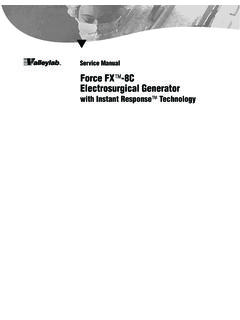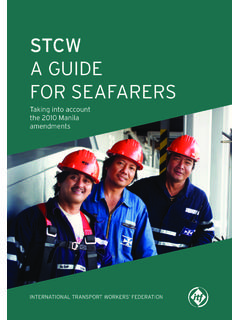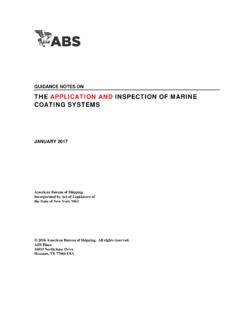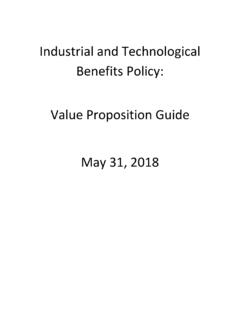Transcription of STCW - International Transport Workers' Federation
1 stcw A guide for seafarersTaking into account the 2010 Manila amendmentsRevised 20172 ITF stcw A guide for seafarers ITF stcw A guide for seafarers 3 ForewordThe stcw Convention and Code is continually being updated and amended to suit the changing requirements of the maritime industry. The ITF have produced previous guidance for seafarers under stcw 95 and the 2010 Manila amendments that re ect the necessary quali cations and experience of a seafarer dependent on their role and type of ship they are employed on. The ITF, in conjunction with the Nautilus Federation , have produced this revised guidance to incorporate all the changes and amendments introduced since 2010.
2 It is essential that all seafarers intending to sail on International vessels, after 1st January 2017, are fully compliant with the stcw Convention and Code and trust this guidance will be a useful aid to ensure a trouble free transition for all ITF will continue to revise these Guidance and treat them as a live document to be amended as 2017 ITF ITF stcw A guide for seafarersContentsAbout this guide 7 Section 1: The stcw Convention 10 Layout of the convention 10 Deadlines to meet 10 Glossary of terms 11 Requirements Additional de nitions and requirements of the 12 amended stcw Convention Section 2: Certi cation requirements 13 Part 1 stcw certi cates Certi cates 14 Certi cation paths 16 General requirements for o cers 17 General requirements for ratings 18 Part 2 Certi cates and general requirements by rank Master 21 Chief mate 22 O cer in charge of a navigational watch 23 Ratings forming part of a navigational watch 24 Able seafarer deck 25 Radio operators 26 Chief engineer 27 Second engineer 28 O cer in charge of an engineering watch 29 electro -technical o cer 30 Ratings forming part of an engineering watch 31 Able seafarer engine 32 electro -technical ratings 33 Any other crew member 34 Part 3 Other certi cates For personnel
3 On any type of ship 35 Additional non-mandatory training within the 2010 stcw 36 For personnel on tankers 37 For personnel on passenger ships 37 Part 4 Training issues Education and training issues 38 Simulator training under stcw 38 English language requirements 38 ITF stcw A guide for seafarers 5 The use of distance learning and e-learning 39 Onboard training and assessment 39 Responsibilities of companies 39 Implementation of the ISM code relevant to stcw 39 GMDSS (Global Maritime Distress and Safety System) certi cates 39 Medical tness standards 39 Section 3: Onboard requirements 44 Certi cates and documentary evidence to be carried onboard 44 Mandatory safety and ship -board familiarisation training 44 Onboard training and assessment 45 Seagoing service 46 Alcohol and drug consumption 46 Control provisions 47 Penalties 48 Regulations a ecting watch-keeping personnel duty 48 Section 4: Implications of amendments to stcw holders 51 Upgrading and revalidation 52 Additional competence requirements under 2010 stcw 53 Master and deck department 53 Engine department 53 Section 5.
4 Where to nd more information on stcw 56 Annex A List of countries party to stcw 57 Annex B IMO Circular ( ) on Guidance for Port State Control inspectors in respect 58 of certi cates of competence issued under the provisions of the stcw ConventionAnnex C Summary of requirements 60 Annex D Amendments and additional requirements 61 1 January 2012 to 1 January 2017 Annex E List of certi cates or documentary evidence required under the stcw Convention 65 6 ITF stcw A guide for seafarers ITF stcw A guide for seafarers 7 About this guideThis guide is aimed at seafarers of all ranks and nationalities. Its main purpose is to help you nd out how the 2010 Manila amendments to the stcw will a ect you.
5 Although we have tried to make this guide as accurate as possible, you should contact the maritime Administration issuing your certi cate(s) of competency and endorsement(s) for speci c information on the national requirements and deadlines you must 1 gives background information on the amended stcw Convention, including deadlines to meet, and provides a brief glossary of 2 outlines the certi cates you need to hold before signing on a ship in orderto ensure that you comply with the amended stcw . This section consists of four parts. Part 1 tells you about stcw certi cates, certi cation paths and general requirements for o cers and ratings. Part 2 lists the certi cates and general requirements demanded according to rank.
6 Part 3 tells you what certi cates you need, depending on your function on board and the type of vessel you are working on. Part 4 gives guidance on training establishments, simulator requirements, English language and GMDSS certi 3 deals with the requirements you need to meet once you are on board. This includes what documentation you must have with you at all times, ship -speci c familiarisation training, training records and sea-going service. It also covers the regulations on alcohol and drug consumption, control procedures and is also a section applying to watch-keeping personnel only, o cers and ratings, on rest hour regulations and watch-keeping 4 tells you what you need to do to if you are a holder of an stcw -95 certi cate and need to update your certi cate to 2010 amended stcw .
7 This section includes tables that summarise by rank the additional competencies you need to demonstrate to upgrade your certi , Section 5 lists other sources of information you can consult should you want to know more about the 2010 amended stcw .^ This guide is produced by the International Transport Workers Federation (ITF). ^ You can download a free version from our website at ITF stcw A guide for seafarersSection 1: stcw Convention10 The stcw Convention ITF stcw A guide for seafarersthis guide you will nd a list of all countries that are parties to the current convention and the dates of acceptance but does not indicate those who are implementing fully the 2010 amendments.
8 Governments must submit reports on their compliance to the IMO by 1 January of the conventionThe stcw Convention is a book consisting of three sections. 1. The articles: outline the legal responsibilities a party has to The Annex: gives technical details on how the legal responsibilities referred to in the articles should be The stcw Code: speci es in more depth the technical details contained in the annex. It contains part A and part A: Mandatory standards of training, certi cation and B: Recommended guidelines (not mandatory) on training, certi cation and regulations in the annex should be read in conjunction with the relevant section of the stcw Code (part A).
9 It is a good idea to familiarise yourself with the convention. After all, the standards of competence that you are expected to meet are speci ed there. A copy of the stcw Convention is normally kept on board all sea-going merchant to meetThe 2010-amended stcw Convention came into force on 1 January 2012. However, there is a ve year transitional period, until 1 January 2017, to allow for a phased in implementation of the provisions. After January 2017, all seafarers are required to meet stcw 2010 standards. The three important dates to remember are:1 January 2012 The stcw Convention comes into force for all countries party to the convention. From 1 January 2012 onwards, requirements for the new minimum rest hours and a record of hours of work must be complied with.
10 For a period of ve years, until 1 February 2017, on a national basis the di erent revised regulations contained in the 2010-amended convention will be phased in. During this ve year transitional period, a party may continue to issue certi cates of competency in accordance with its previous practices, however from 1 July 2013 new seafarers-training and competence should comply with the 2010-amended stcw stcw ConventionThe key to maintaining a safe shipping environment and keeping our oceans clean lies in all seafarers across the world observing high standards of competence and professionalism in the duties they perform on-board. The International Convention on Standards of Training, Certi cation and Watchkeeping for Seafarers 1978, as amended in 1995 and again in 2010, sets those standards, governs the award of certi cates and controls watchkeeping arrangements.







